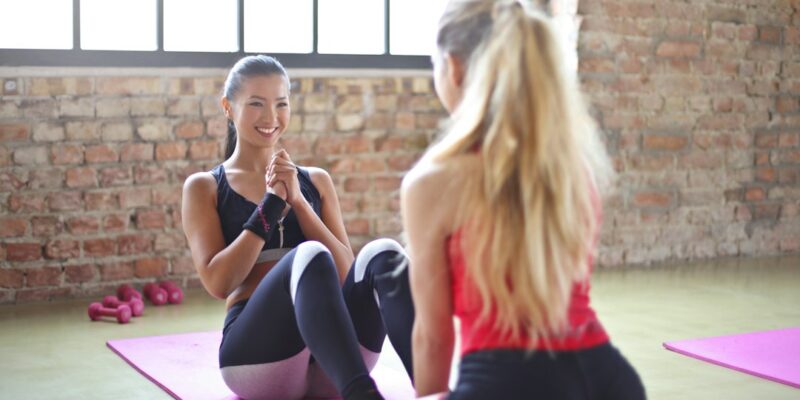
5 Days of Dumbbell Delight: A Complete Workout Guide for All Fitness Levels
Welcome to 5 Days of Dumbbell Delight: A Complete Workout Guide! In this blog post, we will be exploring the benefits of incorporating dumbbell workouts into your fitness routine and providing a comprehensive guide to help you get started. Whether you are a beginner, intermediate, or advanced fitness enthusiast, there is something for everyone in this guide.
Dumbbell workouts are an excellent way to build strength, increase muscle tone, and improve overall fitness. They offer a wide range of exercises that target different muscle groups, making them versatile and effective. Additionally, dumbbells are convenient and affordable, making them accessible to anyone looking to enhance their fitness journey.
Key Takeaways
- Dumbbell workouts are beneficial for all fitness levels, from beginners to advanced.
- Day 1 focuses on upper body exercises for beginners, while Day 2 targets lower body exercises for intermediate levels.
- Day 3 offers a full-body workout for advanced fitness levels, while Day 4 incorporates HIIT for fat loss.
- Day 5 introduces dumbbell yoga for flexibility and mobility.
- Proper form and technique are crucial for effective and safe dumbbell workouts.
Benefits of Dumbbell Workouts for All Fitness Levels
One of the main benefits of incorporating dumbbell workouts into your fitness routine is increased strength and muscle tone. Dumbbells allow you to target specific muscle groups and perform exercises that engage multiple muscles at once. This helps to build lean muscle mass and improve overall strength.
Another benefit of dumbbell workouts is improved balance and stability. When performing exercises with dumbbells, you are required to engage your core muscles to maintain proper form and stability. This not only helps to improve balance but also strengthens the core muscles.
Dumbbells also offer versatility in exercises. You can perform a wide range of exercises with dumbbells, targeting different muscle groups and working on various fitness goals. From bicep curls to shoulder presses to lunges, the possibilities are endless with dumbbells.
Lastly, dumbbells are convenient and affordable. Unlike other gym equipment, dumbbells are compact and easy to store at home. They are also relatively inexpensive compared to other fitness equipment, making them a cost-effective option for those on a budget.
Day 1: Upper Body Dumbbell Exercises for Beginners
If you are new to dumbbell workouts, Day 1 is the perfect place to start. This workout focuses on the upper body and is designed for beginners who are looking to build strength and tone their arms, chest, back, and shoulders.
Before starting any workout, it is important to warm up your muscles to prevent injury. Begin with some light cardio exercises such as jogging in place or jumping jacks for 5-10 minutes. This will increase blood flow to your muscles and prepare them for the workout ahead.
For the upper body workout, you can start with dumbbell exercises such as bicep curls, tricep kickbacks, chest presses, bent-over rows, shoulder presses, and lateral raises. Aim for 2-3 sets of 10-12 repetitions for each exercise. Remember to start with lighter weights and gradually increase the weight as you become more comfortable and stronger.
After completing the workout, it is important to cool down and stretch your muscles. This will help to prevent muscle soreness and improve flexibility. Perform stretches such as tricep stretches, chest stretches, shoulder stretches, and upper back stretches for 5-10 minutes.
Day 2: Lower Body Dumbbell Exercises for Intermediate Fitness Levels
| Exercise | Sets | Reps | Weight (lbs) | Rest (sec) |
|---|---|---|---|---|
| Dumbbell Squats | 3 | 12-15 | 20-30 | 60 |
| Dumbbell Lunges | 3 | 12-15 | 10-20 | 60 |
| Dumbbell Deadlifts | 3 | 12-15 | 20-30 | 60 |
| Dumbbell Calf Raises | 3 | 15-20 | 10-20 | 60 |
Day 2 of the dumbbell workout guide focuses on the lower body and is designed for intermediate fitness levels. This workout will help to strengthen and tone your legs and glutes.
As with any workout, it is important to warm up your muscles before starting. Begin with some light cardio exercises such as jogging or cycling for 5-10 minutes. This will increase blood flow to your muscles and prepare them for the workout ahead.
For the lower body workout, you can start with dumbbell exercises such as squats, lunges, deadlifts, step-ups, and glute bridges. Aim for 2-3 sets of 10-12 repetitions for each exercise. Again, start with lighter weights and gradually increase the weight as you become more comfortable and stronger.
After completing the workout, it is important to cool down and stretch your muscles. Perform stretches such as quad stretches, hamstring stretches, calf stretches, and glute stretches for 5-10 minutes.
Day 3: Full-Body Dumbbell Workout for Advanced Fitness Levels
Day 3 of the dumbbell workout guide is a full-body workout designed for advanced fitness levels. This workout will challenge your entire body and help to improve overall strength and fitness.
As always, start with a warm-up to prepare your muscles for the workout. Begin with some light cardio exercises such as jumping jacks or high knees for 5-10 minutes.
For the full-body workout, you can incorporate exercises such as dumbbell squats, dumbbell lunges, dumbbell chest presses, dumbbell bent-over rows, dumbbell shoulder presses, and dumbbell deadlifts. Aim for 2-3 sets of 10-12 repetitions for each exercise. Use heavier weights that challenge you but still allow you to maintain proper form.
After completing the workout, cool down and stretch your muscles. Perform stretches such as full-body stretches, focusing on all major muscle groups, for 5-10 minutes.
Day 4: Dumbbell HIIT (High-Intensity Interval Training) for Fat Loss
Day 4 of the dumbbell workout guide introduces high-intensity interval training (HIIT) using dumbbells. HIIT is a popular training method that involves short bursts of intense exercise followed by periods of rest or low-intensity exercise. This type of training has been shown to be effective for fat loss and improving cardiovascular fitness.
To perform a dumbbell HIIT workout, choose 4-5 exercises that target different muscle groups. Perform each exercise at maximum intensity for 30 seconds, followed by 10 seconds of rest. Repeat this circuit for a total of 4-5 rounds.
Some examples of dumbbell exercises for HIIT include dumbbell thrusters, dumbbell burpees, dumbbell swings, dumbbell renegade rows, and dumbbell mountain climbers. Choose weights that challenge you but still allow you to maintain proper form throughout the workout.
After completing the HIIT workout, cool down and stretch your muscles. Perform stretches such as quad stretches, hamstring stretches, calf stretches, and shoulder stretches for 5-10 minutes.
Day 5: Dumbbell Yoga for Flexibility and Mobility
Day 5 of the dumbbell workout guide combines the benefits of dumbbells with the practice of yoga. Yoga is a holistic exercise that focuses on flexibility, mobility, and mindfulness. By incorporating dumbbells into yoga poses, you can enhance the benefits and challenge your muscles in new ways.
To perform a dumbbell yoga workout, choose a series of yoga poses that target different muscle groups. Hold each pose for 30-60 seconds while incorporating dumbbells into the movement. For example, you can hold dumbbells while performing warrior poses or use them to add resistance to your stretches.
Some examples of dumbbell yoga exercises include dumbbell warrior II pose, dumbbell chair pose, dumbbell forward fold, and dumbbell pigeon pose. Choose lighter weights that allow you to maintain proper form and flow through the poses with ease.
After completing the dumbbell yoga workout, cool down and stretch your muscles. Perform stretches such as full-body stretches and deep breathing exercises for 5-10 minutes.
Tips for Proper Dumbbell Form and Technique
When performing dumbbell exercises, it is important to maintain proper form and technique to prevent injury and maximize results. Here are some tips to help you achieve proper form:
1. Start with lighter weights: It is important to start with lighter weights and gradually increase the weight as you become more comfortable and stronger. This will help you maintain proper form and reduce the risk of injury.
2. Engage your core: When performing dumbbell exercises, engage your core muscles to maintain stability and proper form. This will help to protect your lower back and improve overall strength.
3. Keep your movements controlled: Avoid using momentum to lift the weights. Instead, focus on slow and controlled movements to engage the target muscles effectively.
4. Maintain proper posture: Keep your spine neutral and shoulders relaxed throughout the exercises. Avoid hunching or rounding your back, as this can lead to injury.
5. Breathe properly: Remember to breathe throughout the exercises. Inhale during the eccentric phase (lowering the weight) and exhale during the concentric phase (lifting the weight).
How to Choose the Right Dumbbell Weight for Your Fitness Level
Choosing the right dumbbell weight is crucial for a safe and effective workout. Here are some factors to consider when choosing the right weight:
1. Fitness level: Beginners should start with lighter weights and gradually increase the weight as they become more comfortable and stronger. Intermediate and advanced fitness levels can choose heavier weights that challenge them but still allow them to maintain proper form.
2. Exercise difficulty: Some exercises require more strength and stability than others. For example, bicep curls require less weight compared to squats or deadlifts. Adjust the weight accordingly based on the exercise difficulty.
3. Repetitions and sets: If you are aiming for higher repetitions (12-15), choose a weight that allows you to complete all repetitions with proper form. If you are aiming for lower repetitions (6-8), choose a heavier weight that challenges you but still allows you to maintain proper form.
4. Listen to your body: Pay attention to how your body feels during the exercises. If the weight feels too light or too heavy, adjust accordingly. It is important to find a weight that challenges you but still allows you to maintain proper form.
Incorporating Dumbbell Workouts into Your Fitness Routine
Incorporating dumbbell workouts into your fitness routine can have numerous benefits for all fitness levels. From increased strength and muscle tone to improved balance and stability, dumbbells offer a versatile and effective way to enhance your fitness journey.
By following the 5 Days of Dumbbell Delight: A Complete Workout Guide, you can target different muscle groups and work towards your fitness goals. Remember to start with lighter weights and gradually increase the weight as you become more comfortable and stronger.
Consistency and progression are key when it comes to incorporating dumbbell workouts into your fitness routine. Aim to perform these workouts 2-3 times per week and gradually increase the intensity and weight as you progress.
So grab your dumbbells and get ready to embark on a journey of strength, tone, and overall fitness. With dedication and perseverance, you will be amazed at the results you can achieve with dumbbell workouts.
If you’re looking for a comprehensive 5-day dumbbell workout routine, you’ll definitely want to check out this article on Wave Magnets. They have put together a fantastic guide that covers everything you need to know about maximizing your gains with dumbbells. From targeting specific muscle groups to incorporating progressive overload, this article provides valuable insights and tips to help you achieve your fitness goals. Don’t miss out on this informative resource – click here to read the full article: 5-Day Dumbbell Workout Guide.
FAQs
What is a dumbbell workout?
A dumbbell workout is a type of strength training exercise that involves the use of dumbbells, which are handheld weights that come in various sizes and weights.
What are the benefits of a dumbbell workout?
A dumbbell workout can help increase muscle strength, improve bone density, boost metabolism, and enhance overall fitness and health.
What is a 5 day dumbbell workout?
A 5 day dumbbell workout is a workout plan that involves performing dumbbell exercises for five consecutive days, targeting different muscle groups each day.
What are some examples of dumbbell exercises?
Some examples of dumbbell exercises include bicep curls, tricep extensions, shoulder presses, chest presses, squats, lunges, and deadlifts.
What should I consider before starting a 5 day dumbbell workout?
Before starting a 5 day dumbbell workout, it is important to consult with a healthcare professional to ensure that it is safe for you to engage in this type of exercise. It is also important to start with lighter weights and gradually increase the weight as you become stronger.

















